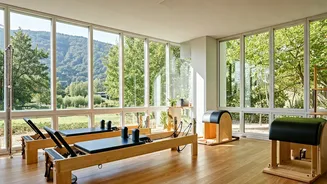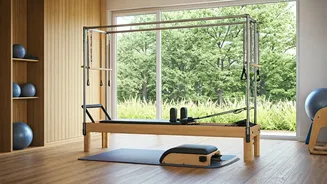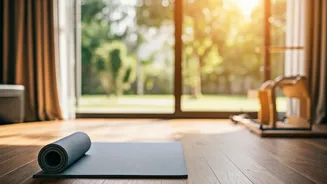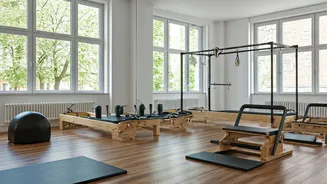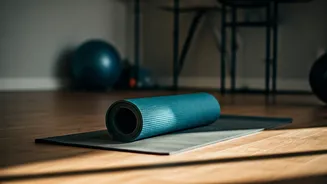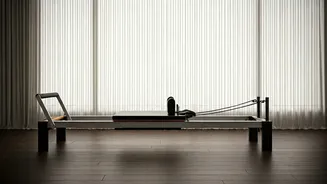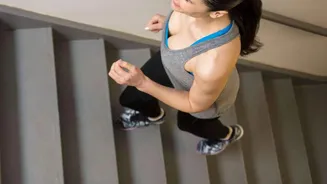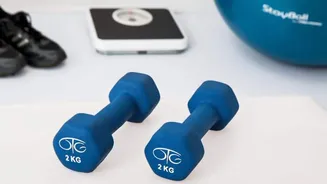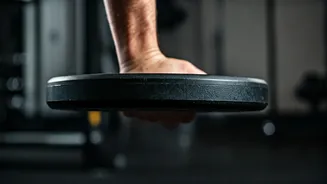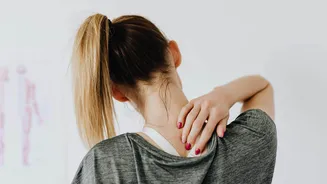Posture From Core
Pilates is exceptional at improving posture by strengthening the deep core muscles. It's a method that works from the inside out, addressing imbalances
that can lead to poor posture. Traditional gym workouts often focus on larger muscle groups, neglecting the core, which is essential for supporting the spine and maintaining proper alignment. Walking is a good activity, but it does not always actively engage the core muscles to the degree that Pilates does. With Pilates, you're constantly aware of your posture and how you carry yourself, leading to noticeable improvements over time. The emphasis on core strength means a stronger back and better balance, which reduces strain and the likelihood of injuries in everyday movements. Practicing Pilates at home requires simple exercises such as the hundred, roll-ups, and pelvic tilts, all of which specifically target the core. Regular practice leads to a more upright and confident posture, enhancing your overall physical appearance and well-being.
Strength Without Strain
One of Pilates's main advantages over traditional gym exercises is its ability to build strength without putting excessive strain on the joints. Weightlifting in a gym, while effective for building muscle mass, can be hard on the joints, particularly for those with pre-existing conditions or those just starting. Walking, on the other hand, is a low-impact exercise but might not provide enough resistance to significantly improve muscle strength. Pilates uses controlled movements and resistance, often from your own body weight or light equipment, to build strength. This approach is gentler on the joints, making it suitable for people of all ages and fitness levels. It focuses on the use of precise movements that engage multiple muscle groups simultaneously, leading to efficient and balanced strength development. This means you will become stronger, but with reduced risk of injury. At-home Pilates routines, even those using minimal equipment, can effectively enhance muscular strength. Exercises like planks, push-ups (modified), and side leg lifts provide strength development in a low-impact manner, contributing to overall physical resilience.
Flexibility Improvement
Pilates is designed to enhance flexibility and range of motion. Unlike gym workouts, which might prioritize strength over flexibility, or walking, which may offer minimal flexibility benefits, Pilates puts a strong emphasis on stretching and lengthening muscles. Exercises in Pilates involve slow, controlled movements that challenge your body's flexibility. This makes it a great choice for those looking to improve their physical capabilities. Increased flexibility means better mobility, fewer muscle strains, and improved athletic performance. Practicing Pilates at home incorporates movements like spinal twists, hamstring stretches, and side bends. These exercises help release tension in the muscles and increase the body’s range of motion. Regular practice will allow you to bend, reach, and move with greater ease and efficiency. This leads to a more supple and adaptable body, reducing the risk of injuries and contributing to a more active and fulfilling lifestyle.
Mind-Body Connection
Pilates actively promotes the development of a strong mind-body connection. This sets it apart from both gym workouts, which often focus on physical exertion alone, and walking, which can be done without much conscious awareness of your body. Pilates teaches you to be more aware of your body's movements and how different muscle groups work together. Every exercise requires your full attention, which helps improve focus and mental clarity. This enhanced awareness can be taken beyond the exercise mat, leading to improved posture, better balance, and greater ease in daily activities. During an at-home Pilates session, your focus is on controlled breathing, precise movements, and the coordination between your mind and body. This helps relieve stress and reduce muscle tension. Integrating the mind-body connection into your fitness routine ensures that your physical health is paired with mental well-being, leading to an overall healthier and more balanced lifestyle.
Home Practice Guidelines
Pilates is highly adaptable to a home environment, and it is a good alternative to gym visits or simple walking. At-home practice removes some of the barriers often associated with gym workouts, such as travel time and scheduling. Several resources, including online tutorials and workout videos, are readily available, making it accessible for everyone, regardless of fitness level. When getting started, consider designating a dedicated space in your home to practice. Choose a quiet area where you won't be interrupted and can focus on your exercises. Before beginning any Pilates routine, warming up is key. Begin with some light cardio, like marching in place or arm circles, followed by dynamic stretches. To ensure effective and safe practice, always focus on proper form. If you're unsure about the movements, take advantage of the many online resources available. Listen to your body and avoid pushing yourself too hard, especially when starting. Pilates is about quality of movement over quantity; focus on controlled and precise actions rather than rushing through exercises. Building consistency into your routine, even with short sessions, is more beneficial than occasional long workouts. Aim for at least 20-30 minutes of Pilates practice, three to four times a week.
